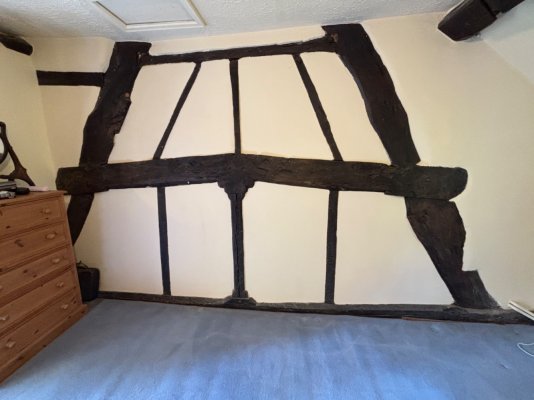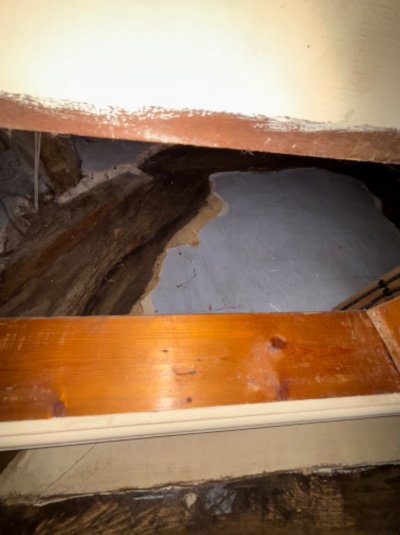Captain P
Member
- Messages
- 10
- Location
- Staffordshire
Is it possible to date part of a property structure through old paintwork, either stylistically or by scientific analysis of the material?
Tree ring dating has failed to yield a result so I am reliant on architectural features and decoration.
The early structure is open hall cruck with smoke from a central hearth escaping through a thatched roof. Probably 16th century. A chimney was inserted, the roof raised and ceilings introduced above the ground floor rooms probably during the 17th century. Ceilings were not introduced above the bedrooms until a later date. Possibly not before the 20th century. This can be inferred because dividing walls inside the modern day (very small) loft spaces have been painted blue, and some rafters painted white, which indicates the bedroom remained open to the roof after the 17th century improvements - no sane person paints their loft.
The first photo shows the cruck frame in the bedroom. The floor, the dividing partition and the ceiling did not exist in the original building. The second photo is taken through the loft hatch. Blue paint can be seen above as well as below the cruck blade, as well as some exposed plaster work. I could not get the angle to show white painted rafters.
Does anyone have any suggestions about the time period when
 this painting was carried out? This might confirm or contradict my theories about construction dates.
this painting was carried out? This might confirm or contradict my theories about construction dates.
Tree ring dating has failed to yield a result so I am reliant on architectural features and decoration.
The early structure is open hall cruck with smoke from a central hearth escaping through a thatched roof. Probably 16th century. A chimney was inserted, the roof raised and ceilings introduced above the ground floor rooms probably during the 17th century. Ceilings were not introduced above the bedrooms until a later date. Possibly not before the 20th century. This can be inferred because dividing walls inside the modern day (very small) loft spaces have been painted blue, and some rafters painted white, which indicates the bedroom remained open to the roof after the 17th century improvements - no sane person paints their loft.
The first photo shows the cruck frame in the bedroom. The floor, the dividing partition and the ceiling did not exist in the original building. The second photo is taken through the loft hatch. Blue paint can be seen above as well as below the cruck blade, as well as some exposed plaster work. I could not get the angle to show white painted rafters.
Does anyone have any suggestions about the time period when

 this painting was carried out? This might confirm or contradict my theories about construction dates.
this painting was carried out? This might confirm or contradict my theories about construction dates.